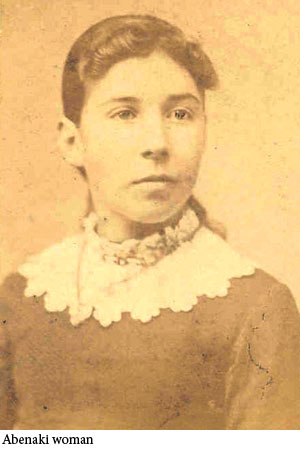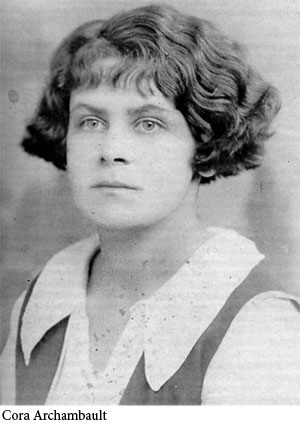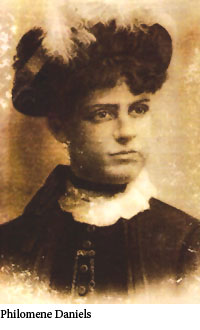Profiles in Fortitude:
Champlainís First Wave
of Women Making History
By Heather Michon

Editor’s Note
In this special edition of Vermont Woman’s “Footnotes in History” series, Heather Michon shares some fascinating facts about some of the women in the Champlain region during the early years of European arrival, from Vermont to Montreal – accompanied by a preview of the Vermont Women’s History Project’s Quadricentennial endeavor.
This summer, residents of Vermont, Quebec, and New York will celebrate that moment when Samuel de Champlain sailed his ship into a lake as yet uncharted by Europeans. He spent only a month on the body of water that would ultimately bear his name, but the impact of his exploration is still with us four centuries later.
As part of the Quadricentennial celebrations, the Vermont Commission on Women (VCW) is sponsoring a year-long look at the women whose lives have intertwined with the lake over those centuries. Under the aegis of the Vermont Women's History Project, an initiative of the VCW, researchers led by historian Julia Lewandoski have spent most of a year looking into the lives of more than a dozen women whose stories are integral to lake history.
Even in 1609, Champlain knew he was not stepping into an uninhabited place. The Champlain Valley basin had been home for paleo-Indians and modern tribes for thousands of years before his arrival. The lake was used for both transportation and food; archaeological evidence shows that tribes often set up seasonal camps on its shores. For native women in the region, the lake was a traditional source of sustenance, instrumental in keeping their people fed and healthy through the long, harsh winters.
Following Champlain's trek, the first European women arrived in the region – among them, his own young bride. Hélène Boullé was the daughter of a powerful advisor to the king; she and Champlain married in 1610, when she was just 12 years old and the explorer was 43. The betrothal agreement stipulated that the two would not cohabitate until Boullé was 14, but that proved to be no problem: Champlain left for a return trip to New France just two months after their wedding, and for the next decade he saw her only when he returned to Europe each winter.
In 1620, Hélène joined him in New France to live in a leaky "chateau" on the banks of the Saint Lawrence River in Quebec City. At the time, only seven French families lived in the colony Champlain had founded. She got on well with the local tribes but found colonial life dreary, and four years later she packed up and headed home. When her husband died on Christmas Day, 1635, Helene became an Ursuline nun and later founded her own convent outside Paris.
Lewandoski regrets that not much more is known of Boullé’s life. “Champlain's wife is a total mystery,” she says. “I wish I could learn about her time in Quebec.”
Two decades after Madame de Champlain’s arrival, fellow French noblewoman Jeanne Mance made the trip. A lay member of the Ursuline order, Mance journeyed to New France as a missionary nurse in 1641. In short order she joined forces with military officer Paul Chomedey de Maisonneuve and together they co-founded the city of Montreal on May 17, 1642. That fall, she founded the Hotel-Dieu – the first hospital in North America.
By 1651, tensions between the local Iroquois and French settlers led to a series of bloody battles and brought the small settlement to the brink of collapse. Mance went to Maisonneuve and urged him to return to France to raise a military force to protect the colony. To assist him, she gave him 22,000 livres she had raised for the construction of a permanent hospital building.
Mance died at the Hotel-Dieu in 1673 at the age of 67.
Another powerful figure in the early European history of the lake was Louise de Ramezay, born to one of the early governors of Montreal. After his death in 1724, she took over the management of his sawmill on the western shores of the lake and eventually acquired two more mills and a tannery. She also became the seigneur, or landlord, of several tracts of land around the Chazy River.

De Ramezay did not like to involve herself in the day-to-day operations of her far-flung enterprises, and among her directives to her mill operators was a stipulation that employees be given an hour a day to work with a tutor stationed at each mill so that they might learn how to read and figure. This was perhaps not so much magnanimous as practical: she wanted to know that her workers could keep the account books without her supervision.
The women of early Canada left behind tantalizing hints of their lives, but the details have been lost to history. "I had a really hard time finding anything about women who lived at Fort St. Frederic, which was the French fort at what is now Chimney Point on the lake," says Lewandoski. This lack of information is “a gap I wish we could have filled."
Settlement in the Champlain Valley proceeded slowly over the next two centuries and the lake itself didn't really become a useful tool for commerce until the early 19th century. The 60-mile-long Champlain Canal, connecting the southern end of the lake with the Hudson River, opened in the fall of 1823. The canal tied the Champlain Valley with the national economy by allowing timber and other goods to flow easily into the global marketplace.
Its heyday lasted only a couple of generations, until railroads took the place of water transport as the cheapest way to get goods to market in the mid-19th century. But like the nearby Erie Canal, the Champlain Canal developed a culture of its own. Women not only took care of their families on the boats, but also took turns at the helm when needed.
Steamboats also enjoyed a brisk trade on the lake during these decades. Philomene Daniels and her husband Louis founded the Daniels Boat Line in the 1860s. She served as pilot on their ferry, "The Water Lily," on its daily runs between Vergennes and Westport, New York. In 1877 she became the first woman to be licensed as a steamboat “pilot and master” in U.S. history. Captain Phil and her boat, "The Victor," were fixtures on the lake for decades. (She even reported a sighting of Champ in the 1870s.) When she retired in 1903, her daughter-in-law Helen Daniels became the country's second female licensed steamboat captain – while raising a family of eight.
With increased trade came the need for lighthouses and markers to keep boats and barges away from dangerous shallows. Visitors to the Shelburne Museum are familiar with the Colchester Reef Lighthouse, which joined the collection in 1952 after more than 60 years of service warning ships of the dangerous shoals a mile off Colchester Point. Most of the light-keepers who served there over the decades did not have families, but in 1882, Walter and Harriet Button moved into the small lighthouse built atop Middle Bunch with their young children for a stay of a decade or more.
Like all lighthouse families, the Buttons had an unusual lifestyle. They kept a cow and extensive gardens on nearby Sunset Island – from where they’d summon the children home by blowing on a conch shell – and went into town about once a month for provisions, but were otherwise alone on the water. For pets, they had a pair of tamed squirrels. When asked how the squirrels got to the island in the first place, Keeper Button would always say: "They made sails of their tails and sailed on a cake of ice."
The ice proved less dependable when Harriet Button went into labor on January 29, 1888. Walter Button summoned a doctor with a pre-arranged signal when events got underway, but thanks to an early-season thaw, the ice was too thin to cross by foot and the doctor's rowboat was trapped in the floes and pushed several miles north. By the time he made his way back to Colchester, little Myrtle had arrived, quite without assistance.


Lake commerce went into steep decline after the expansion of the railroads in the late 1870s, and by the end of World War II it had come into its modern incarnation as a prime recreational site.
The Quadricentennial celebrates a moment of discovery and exploration – traditionally male endeavors. The Women and the Lake project recaptures a different history, one where women were fully engaged in lake-centered life and work, though their contributions went unrecognized. From Abenaki women gathering food along its shores to the wives and daughters of canal-boat captains making endless trips along the canals to the tens of thousands of young women who learned to love the outdoors through summer camps and fishing trips, Lake Champlain has been a source of both material and spiritual nourishment for women and their families for more than four centuries. This joint history will likely continue for many generations to come.
To learn more about women's history on Lake Champlain, visit the Vermont Women's History Project online at www.womenshistory.vermont.gov and click on “Quadricentennial,” or browse the "Women and the Lake” page at the official Quadricentennial Web site, http://celebratechamplain.org, for information and links to Vermont Public Radio's "Women of the Lake” series
Heather Michon is a Vermont woman living in Virginia. She can be contacted at heather.michon@rocketmail.com
|

